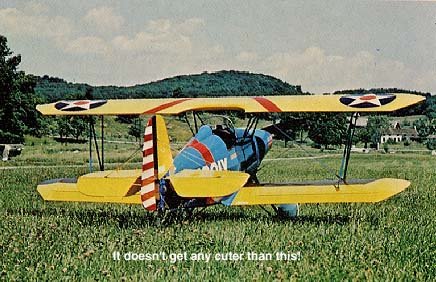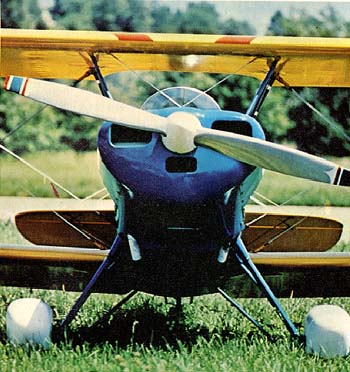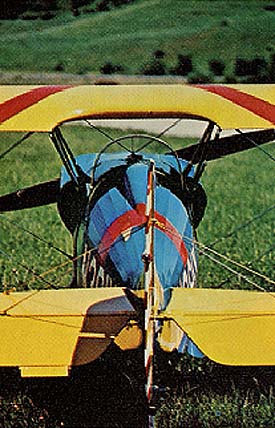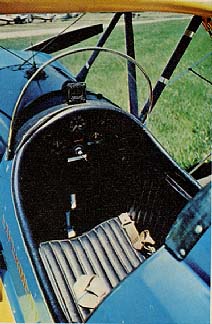

Editor's note: This is one of the first three or four homebuilts that I flew and I think it was my first homebuilt biplane. This was even before I owned a Pitts Special. Was ever that young? Please note how much I say I wiegh at the time. The difference between then and now is almost the exact same number in both pounds and years. At that point I had been writing and takng pictures less than a year and a half. To put it in perspective: Woodstock had happened barely a year before.
The Smith Miniplane is right out of the back of every pilot's mind. It flies in the margins of notebooks and lands on the backs of napkins. We've all doodled something similar when our subconscious takes over and the "perfect" airplane flows out of the pencil. I'm sure, at one time or other, most of us have thought about our own personal little biplane. We've all dreamed, but somehow not many of us get past the doodling stage. Frank Smith did.
Smith was a doodler-dreamer like the rest of us, but he was also a doer. He collected his notes and scratch pads and hammered them into a reality: a flying machine that he thought was the ultimate in pure fun flying. It was everyman's airplane, to be built cheaply, flown easily, and to give a degree of satisfaction to the dreamer. That was 1956.
This is 1970, and I am flying Frank Smith's reality. The wind buffets my helmet and ripples the shoulders of my flight suit, and it is obvious that Frank Smith knew what he was doing. His little airplane is fun -- not dynamite, not specialized aerobatics, not STOL -- just fun. The ailerons are quick and light and the aircraft has enough rudder for nine airplanes and enough elevator for two. It can be flown feet on the floor, if you wish, because slamming the stick hard to one side pivots the nose on a point. There's no adverse yaw, although the nose slides a bit when rolling out without rudder.
 Frank Smith built
the first Miniplane and flew it in 1958. He drew up plans and
got everything set up so his airplane would be available to all
those dreamers who are doers, but not designers. His plans are
complete and better than many on the market. They are done in
the form of a small book of black line drawings, and while adequate
to build the airplane, they are far from production drawings.
On the other hand, you have to fork over only $35 rather than
the usual $125. The Smith plans leave a lot to the imagination,
but I think that's part of the game.
Frank Smith built
the first Miniplane and flew it in 1958. He drew up plans and
got everything set up so his airplane would be available to all
those dreamers who are doers, but not designers. His plans are
complete and better than many on the market. They are done in
the form of a small book of black line drawings, and while adequate
to build the airplane, they are far from production drawings.
On the other hand, you have to fork over only $35 rather than
the usual $125. The Smith plans leave a lot to the imagination,
but I think that's part of the game.
The Mini we flew, N391Y, would make Frank Smith
proud. Right now it's making its owner, Bob Sweeny of Pennington,
New Jersey, proud. The plane was originally built by Lester David,
also of New Jersey, and he foresaw changes that were later incorporated
into the plans. His was probably the first Miniplane with a beefed-up
tail, a trim tab, and double flying wires. The craft changed hands
several times and wound up with Bob Sweeny. Bob apologized to
me for two patches in the otherwise spotless fabric. It seems
a rotary
mower threw a blade through a hangar window and nearly gave 91
Yankee an appendectomy. Considering the fantastically clean and
detailed quality of the airplane, I was more than willing to overlook
a few bandages, especially since he was going to let me fly it.
Except for the modifications already mentioned, 91Y might have been exactly what Smith had in mind when he squatted on his garage floor, chalk in hand. The airplane is traditional wood, tubing, and fabric. It's basic. Airplanes have been built this way since Orville talked Wilbur into giving up the bike shop. The wings are straight and square, making everything as simple as possible. There are no angular splices to make, no really exotic fittings, and all the ribs are the same size; they are the usual truss type built out of spruce strips. Some builders have incorporated pressed aluminum ribs, but that is personal preference. Since there are no ailerons in the upper wing, there is no complex cable assembly, nor any pushrod interconnectors. The top wing is actually a simple slab and looks as if it could be built on a big kitchen table. The original Miniplane was pulled around by a C-85 Continental, but people have shoe-horned engines as big as 150 hp, although that would probably require additional beefing up or prayers before each flight. Sweeny's plane has the C-85.
 In the interest of
simplicity, Smith put a rigid gear on his DSA-1 (Darned Small
Airplane), but more and more builders are changing to some sort
of sprung gear. Some use the tried and true spring-in-a-tube shock
system, while others throw the gear Vs away entirely, preferring
to use a Cessna-type flat spring gear.
In the interest of
simplicity, Smith put a rigid gear on his DSA-1 (Darned Small
Airplane), but more and more builders are changing to some sort
of sprung gear. Some use the tried and true spring-in-a-tube shock
system, while others throw the gear Vs away entirely, preferring
to use a Cessna-type flat spring gear.
Shortly after I flew Sweeny's airplane, he changed his gear, and I'm glad he did. I hit a bump while landing it on grass and it threw the little airplane quite a way back up into the air, causing me to break into an instant sweat.
A Miniplane fits well; it really feels good. Some homebuilts make you feel that accommodating your body was an afterthought in the design, but the Miniplane is extremely comfortable and well laid out. My medical says I'm 70 inches tall and weigh 155 pounds, so any average-sized pilot should have no trouble fitting, though the bigger types might prefer a little more leg room. Visibility over the nose is excellent. I was really surprised at how flat the airplane sits. Even though it's a tail-dragger, the far end of the runway roosts on the top edge of the cowling.
Bob Sweeny has more tailwheel time than most, nearly 1,000 hours of Citabria time alone, but I just couldn't believe 91Y was as squirrelly as he kept telling me. However, since I'm not particularly an ace, I was prepared to believe him. I figured it's short, narrow, and rigid, so I'd play it safe.
Taxiing out, I didn't notice anything particularly scary, although the brakes were a little soft and I couldn't maneuver as tightly as I wanted. The airplane made a believer out of me the second I put the power to it. Maybe I've never flown a real airplane, but I've never flown anything that kept me as busy on takeoff as the Miniplane. This isn't saying that it wants to run for the bushes, but it does have a little torque, and it reacts immediately to the slightest amount of rudder pressure. It's nearly impossible to keep the rudder perfectly centered, so I was constantly using a little rudder one way or the other.
I had the nose a bit too high when I broke ground and it wanted to settle, but when I dropped the nose and let the speed build, it climbed out just fine. Once in the air, the feeling of chasing it down the runway disappeared. It climbed at 85 mph and at about the same rate as a Cherokee 140.
I don't have a great deal of open-cockpit time a few Jungmeisters, the Jungster I, and a Fly-baby-so it's difficult to give a fair evaluation of the wind noise and general cockpit characteristics. I do think that the Miniplane afforded my noggin about as much wind protection as anything else, and more than some. The wind could play with the top of my head and the back of my shoulders. Other than that, there was practically no wind disturbance in the cockpit.
I've already mentioned how nice the controls feel. Some airplanes are supersensitive and give you that tightrope feeling, but the Miniplane is quick enough to be fun while not demanding. The ailerons are much like a Swift's, but the rudder is like nothing else-it has lots.
I hate to admit it, but I fell out of two loops before I got a good one. The airplane is very sensitive to the amount of G force you pull going into a loop. Too much or too little G and you slow down, winding up as I did -- looking around and seeing nothing but blue, wondering where the ground was, while the airplane tries to make up its mind which way to fall. It definitely needs more power, but once you figure out how to play the game, the 85 is enough to give passable loops.
 Because of the gas
venting back down the cowl and into my lap under negative Gs,
I stayed away from slow rolls. Aileron rolls are definitely its
forte, and it does a decent hammerhead. I never did get what I
considered to be a good snap roll, even when using ailerons. That
flat bottom wing doesn't like to stall, so it won't unload quickly
enough to go around fast. Bob says he gets good ones, but he probably
has the right recipe.
Because of the gas
venting back down the cowl and into my lap under negative Gs,
I stayed away from slow rolls. Aileron rolls are definitely its
forte, and it does a decent hammerhead. I never did get what I
considered to be a good snap roll, even when using ailerons. That
flat bottom wing doesn't like to stall, so it won't unload quickly
enough to go around fast. Bob says he gets good ones, but he probably
has the right recipe.
Speaking of stalls, it doesn't; or if it does, it does just barely. Power off, you can waddle around with the stick all the way back. Using power and horsing it back to get an accelerated stall, it lets go a little sharper, but even then it's much more docile than I ever figured it to be.
While I was fiddling around with stalls and such, I started thinking about landing. Bob had given me quite a session on setting up the approach, watching the rate of descent, and so forth. The way he talked, I expected it to fall out of the sky like an anchor. I still had altitude, so I pulled the throttle back and watched the altimeter. I don't know whether I was relieved or disappointed when I saw it unwind at about the same rate as a powered-down Cherokee. The plane was settling fast all right, but it was nothing scary. What I did notice was that in simulating a flare-out from a stabilized glide, the altimeter didn't even slow down. Bob was right, fly it in with power. The entire approach was completely normal, and I came down final at about 85 mph, carrying a little power. Following Bob's instructions, I flew it right down to the deck, rotating info a three-point attitude a couple of feet up. I bled power off slowly, and it gently settled into the grass just as if it knew what it was doing. I had touched down and was starting to work on the rudders when I hit the aforementioned bump, which scared me until I realized I still had control. I wasn't swerving all over the airport, but the rudder was still being used. Actually, I don't think the airplane is necessarily that unstable on the ground, but it reacts so quickly and has so much rudder that it's easy to over-control. I've landed many a Citabria in this same piece of grass and never had to touch the rudder, but I had to tend to business in the Miniplane. I can see that it might be a real handful on pavement, especially if the wind isn't coming down the middle.
 I think it's important
to point out that although I know how N391Y flies, it's not necessarily
the way all Miniplanes fly. Homebuilts being what they are, each
one is bound to fly differently, and I could be doing the breed
an injustice by making generalities based on one airplane. If
you are sincerely interested in how the airplane flies, you'd
be well advised to corner as many Miniplane owners as possible
and draw your own conclusions.
I think it's important
to point out that although I know how N391Y flies, it's not necessarily
the way all Miniplanes fly. Homebuilts being what they are, each
one is bound to fly differently, and I could be doing the breed
an injustice by making generalities based on one airplane. If
you are sincerely interested in how the airplane flies, you'd
be well advised to corner as many Miniplane owners as possible
and draw your own conclusions.
A one-word summary of the Miniplane would be fun. It's not especially great in any given area. Its aerobatics are okay, and at 100 mph, it's not a speedball. It's not important that it be totally fantastic at any particular task, however, because its primary job is fun, and it does that well. It's simple to build and easy to fly, although its ground-handling characteristics are such that you'd best log some crosswind Luscombe time before playing with it.
Frank Smith died of a heart attack shortly after finishing the first Miniplane; his wife Dorothy and son Don are carrying on his work, including the development of a two-place version. It's sad that Frank never got to see the popularity his little biplane is enjoying. I can think of no better tribute or memorial to a man than to have his dreams realized and accepted by his peers. The Miniplane is truly accepted.